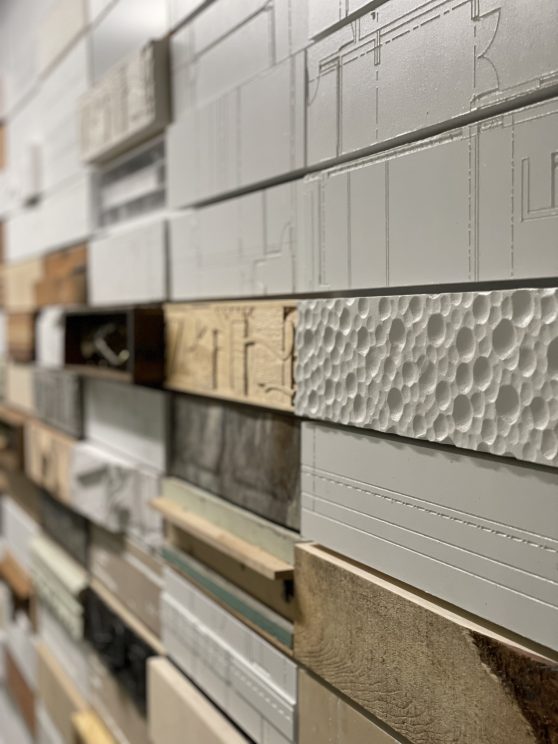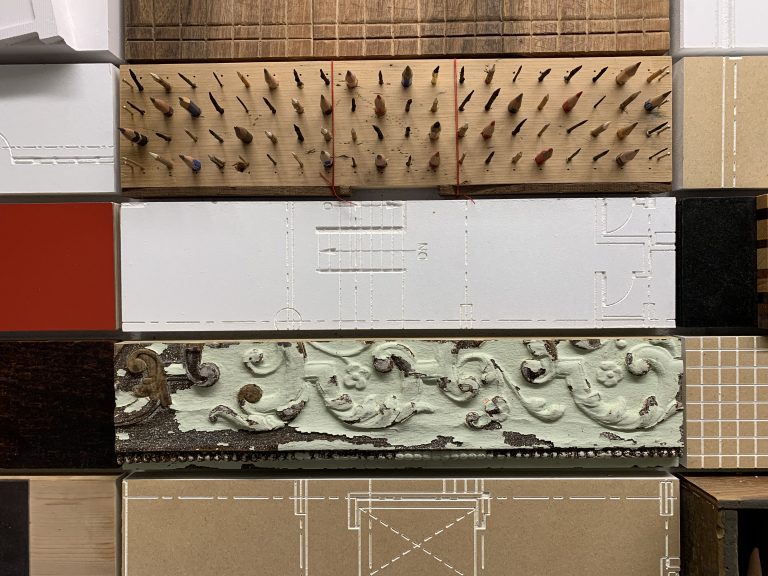New “quilt wall” artwork reflects school’s research and culture of making
November 5, 2021
Time-lapse of the quilt wall installation. Video produced by Jesse Bird and Michelle-Andrea Girouard
Visitors to the Architecture Building at Carleton University are discovering a new participatory artwork called the “quilt wall” that reflects the architecture school’s research and material experimentations in a wide range of media.
“It’s a communal and collaborative project,” says Associate Professor Sheryl Boyle, who has led the endeavor with recent graduate Jesse Bird. “It’s a beautifully fitted piece that reflects the voices of our family and how we think about things by making in the school.”
The multi-coloured quilt wall comprises a grid of tiles covering the entrance wall of the main-floor washroom. Formerly a separated men’s and women’s restroom, it has been renovated over the past year to become what is likely the first gender-neutral facility on the Carleton campus.

The artwork was conceived as an inclusive, participatory project. Its panels are individually designed and produced by faculty members, staff, and students in a uniform size, coordinated through the school’s research labs and fabrication facilities.
Sources include: Carleton Immersive Media Studios (CIMS), Carleton Sensory Architecture and Liminal Technologies Laboratory (CSALT), Carleton Urban Research Lab, Carleton Research | Practice of Teaching | Collaborative (C R | P T | C), and the Carleton Climate Futures Design Lab (the CLIFF).
So far, 39 final pieces have been submitted and installed along with white filler panels, based on fragments of the building floor plans. There is room for a total of 96 panels — more or less the size of the first-year class.
As a steward for the first iteration of the quilt, Boyle anticipates an exciting array of submissions from other members of the school community over time, in materials as varied as rammed earth, 3D printed Ultra-High-Performance Concrete, and recycled cellulose fiberboard.
Woodshop technician Rob Wood is among the staff members who have contributed. His eight tiles demonstrate processes such as laser cutting, CNC routing, sheet metal, and woodworking, including one that pays tribute to the school’s decades of shop-fabricated wood lockers.
Mark MacGuigan, the workshop’s chief technician, made a series of tiles based on the school logo in carved wood, which was then used as a mold to cast copies in cement and plaster. Two others display sheet metal work and forging.
Research on the Republic of Georgia sparked the inspiration for Professor Suzanne Harris-Brandts’s handiwork. The simple, raised-relief pattern is reminiscent of precast concrete panel motifs found throughout the former Soviet Union. However, the design is hand-carved into a piece of Georgian walnut following a technique popular in early 20th-century local vernacular architecture. Such carvings are found on interior columns or as details on exterior balconies.
“Through this hybridization of pattern, material, and technique, I aimed to synthesize two of Georgia’s most dominant historic architectural styles, in turn reflecting the broad range of periods that come together in my research,” she says.
Associate Professor Mariana Esponda submitted three pieces that depict experiments in the conservation program, undertaken with Professor Jack Hollinger at Algonquin College and Parks Canada. Made of wood reclaimed from Parliament Hill, each features a linseed oil finish in either red, green, or clear.

“We are doing practical research on rediscovering and revaluing traditional oil linseed paint finishes and how climate change is affecting the Canadian-built heritage,” says Esponda. “The outcome has the potential to prevent further environmental degradation, and save considerable budget expenditure, due to maintenance of modern paint systems.”

Boyle’s works, meanwhile, are narratives of place and time. One of them is fashioned from wood salvaged from old or demolished houses. It includes beadwork from her 1890-era house and a scrap of blue wood from a home in Isaac’s Harbour, a place in Nova Scotia named after the 18th-century Black settler Isaac Webb.
“All the pieces of wood tell a story even within the block of one piece of quilt,” she notes. “Much like an actual quilt, each of those fabrics had a previous life.”
Another series of Boyle’s work celebrates architectural drawing instruments such as a vintage drafting brush, pencils, and a compass displayed in a shadow box.
The quilt wall, which measures 9.5 feet wide and five feet high, echoes the proportional system of the building, Boyle notes. Each panel is 15 inches by 3.5 inches or half the size of a concrete masonry unit, of which the school is made up.
“We wanted to bring in the idea of dimensions,” she says. “Like all the original pieces of the building, it relates back to a standardized unit.”
Former school director Jill Stoner initiated the idea of an artwork in this location after seeing the opportunity presented by an otherwise blank concrete wall at the washroom entrance.
Recent Master of Architecture graduates Jesse Bird and Stephanie Murray assisted Boyle as artists-in-residence in collaboration with workshop staff. Their work included the intricate design of the mounting and fastening system which makes the artwork float on the wall. They also created panels, coordinated with contributors, and installed the artwork with Boyle.
“It’s an exciting body of work that speaks to the school’s collaborative and creative traditions,” says Bird.
“As part of the ongoing interaction of pedagogy with building details and artwork in the school, the project asks faculty, staff, and research labs to contribute a panel to this new collaborative and democratic installation,” he says.
“It was essential to allow the project to evolve over time, acting as a living artifact to the many methods of thinking and material research within the school.”
The team mounted the first iteration of the quilt in September, in time for the first day of classes.
“As our people, media, and reflections on the built environment change, the quilt will be able to change with them,” says Boyle. “As these ideas emerge, other curators can lead the project.”
The long-term vision for the Quilt will include a digital version of the wall that will highlight the entirety of the project. It will allow viewers to read about each panel’s contributor, along with a description of the materials and methods used.
